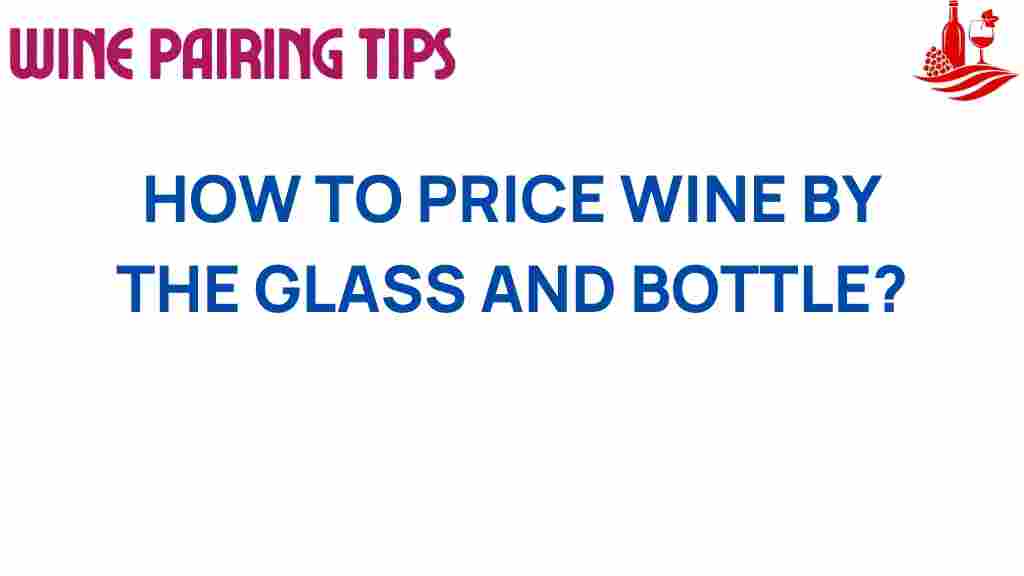Uncorking the Secrets: How to Price Wine by the Glass and Bottle
When it comes to enhancing the dining experience, wine plays a pivotal role in many restaurants. However, successful wine sales depend heavily on effective wine pricing strategies. In this article, we will explore the nuances of wine pricing, focusing on the glass vs bottle debate, consumer behavior, and how to optimize profit margins through thoughtful pricing techniques.
Understanding Wine Pricing
The first step in mastering wine pricing is understanding the various factors that influence it. Wine pricing is not just about covering costs; it’s a combination of strategic choices that reflect consumer preferences, market trends, and competition.
Key Components of Wine Pricing
- Cost of Goods Sold (COGS): This includes the purchase price of the wine, shipping, taxes, and other costs associated with acquiring the product.
- Markup: Most restaurants apply a markup to wine prices to cover overhead and generate profit. Commonly, wine is marked up 2 to 3 times the COGS.
- Market Trends: Keeping an eye on current wine trends can help in setting competitive prices that attract customers.
- Consumer Behavior: Understanding what customers are willing to pay for specific wines can guide pricing decisions.
Glass vs Bottle Pricing
One of the most debated aspects of wine pricing is how to price wine by the glass versus by the bottle. Each method has its pros and cons, and the decision often comes down to the restaurant’s strategy.
Pricing Wine by the Glass
Pricing wine by the glass allows customers to try different varieties without committing to a full bottle. Here are some important considerations:
- Price Point: Glass prices typically range from 1/4 to 1/3 of the bottle price. This makes it accessible for customers who may not want to invest in a whole bottle.
- Profit Margins: Selling wine by the glass can lead to higher profit margins if managed correctly. The key is to ensure that the glass price reflects the quality and experience of the wine.
- Inventory Management: Offering wine by the glass encourages turnover of stock, which is essential for keeping the wine menu fresh.
Pricing Wine by the Bottle
On the other hand, pricing wine by the bottle can create a different dining experience:
- Higher Revenue Per Sale: Customers are likely to spend more on a bottle than on multiple glasses, increasing average table revenue.
- Encourages Sharing: Bottles promote a communal dining experience, which can enhance customer satisfaction and encourage larger groups.
- Exclusive Offerings: Higher-end wines are often better marketed and more appealing when sold by the bottle, allowing for premium pricing strategies.
Developing Your Wine Menu Strategy
Your wine menu is a crucial element of your restaurant’s branding and can significantly impact wine sales. Here are some strategies to consider:
- Diverse Selection: Offer a range of wines that cater to different tastes and price points to attract a wider audience.
- Highlight Pairings: Suggest food pairings with your wines to enhance the dining experience and encourage wine sales.
- Seasonal Rotations: Change your wine menu seasonally to keep it fresh and exciting, which can drive repeat visits.
Effective Pricing Techniques
Implementing effective pricing techniques is essential for maximizing profit margins. Here are some methods to consider:
- Psychological Pricing: Price wines just below a round number (e.g., $9.99 instead of $10) to make them seem more appealing.
- Bundles and Promotions: Offer wine pairings with meals at a discounted rate to encourage more sales.
- Dynamic Pricing: Adjust wine prices based on demand, events, or even time of day to maximize revenue.
Analyzing Consumer Behavior
Understanding consumer behavior is crucial for effective wine pricing. Here are some ways to analyze and respond to customer preferences:
- Feedback and Surveys: Regularly gather feedback from customers regarding their wine preferences and pricing perceptions.
- Sales Data Analysis: Monitor which wines sell best and adjust your pricing or offerings accordingly.
- Trend Watching: Stay updated on wine trends and consumer preferences to adapt your wine menu and pricing strategies.
Troubleshooting Common Wine Pricing Issues
Even with careful planning, issues can arise in wine pricing. Here are common problems and solutions:
- Problem: Slow-moving inventory.
Solution: Consider discounting certain wines, offering them as part of a special, or promoting them with food pairings. - Problem: Customer complaints about pricing.
Solution: Train staff to effectively communicate the value and quality behind each wine. - Problem: Poor sales of premium wines.
Solution: Create exclusive tasting events or incorporate these wines into special promotions.
Conclusion
Effective wine pricing is an art that involves understanding the delicate balance between cost, consumer behavior, and market trends. By considering the glass vs bottle pricing strategies, developing a robust wine menu, and employing innovative pricing techniques, restaurants can enhance wine sales and profitability. Remember, a well-thought-out wine pricing strategy not only boosts profit margins but also enriches the overall dining experience.
For more insights on restaurant strategies and enhancing your wine selection, visit this resource. You can also explore expert tips on wine pricing at this informative blog.
This article is in the category Tips and created by Wine Pairing Tips Team
